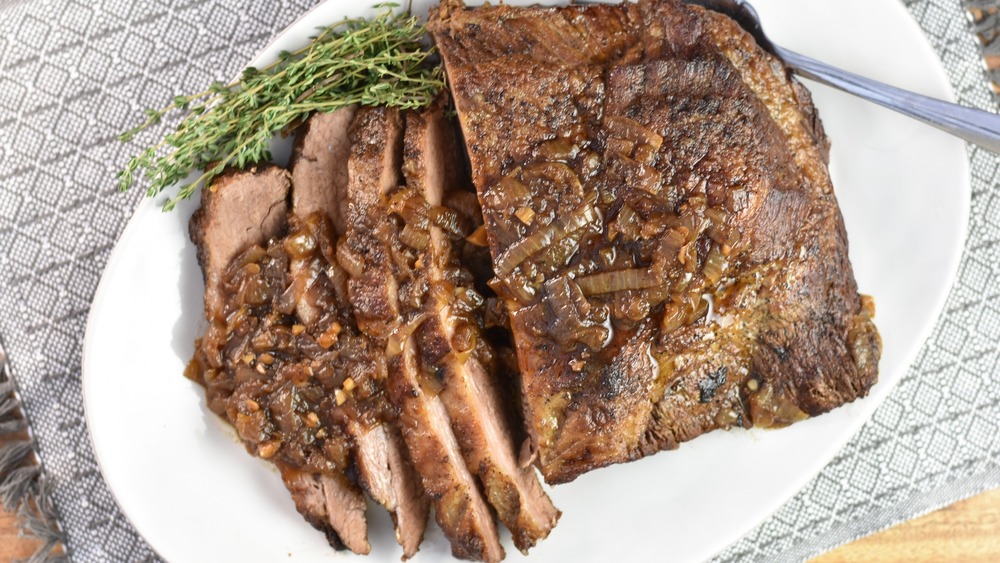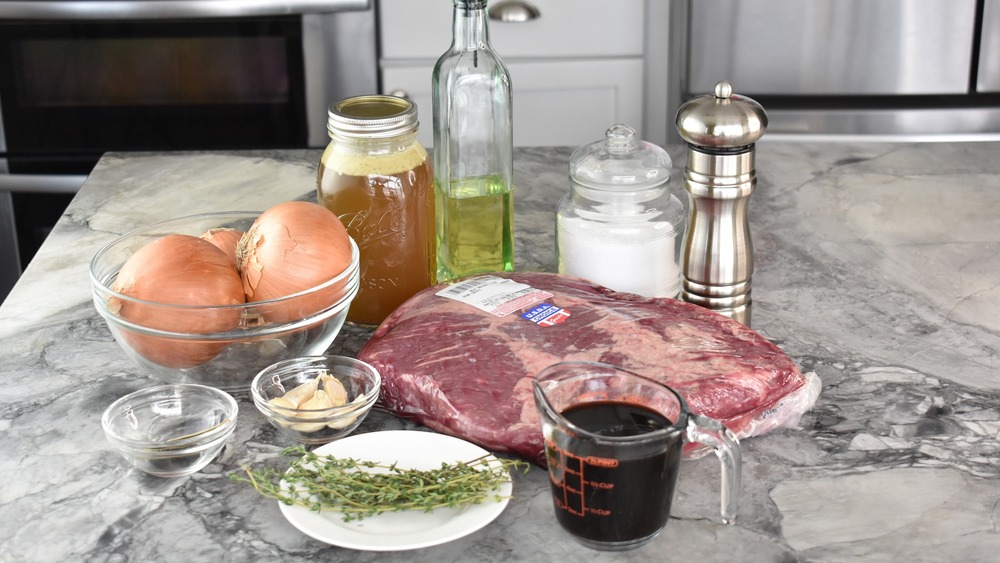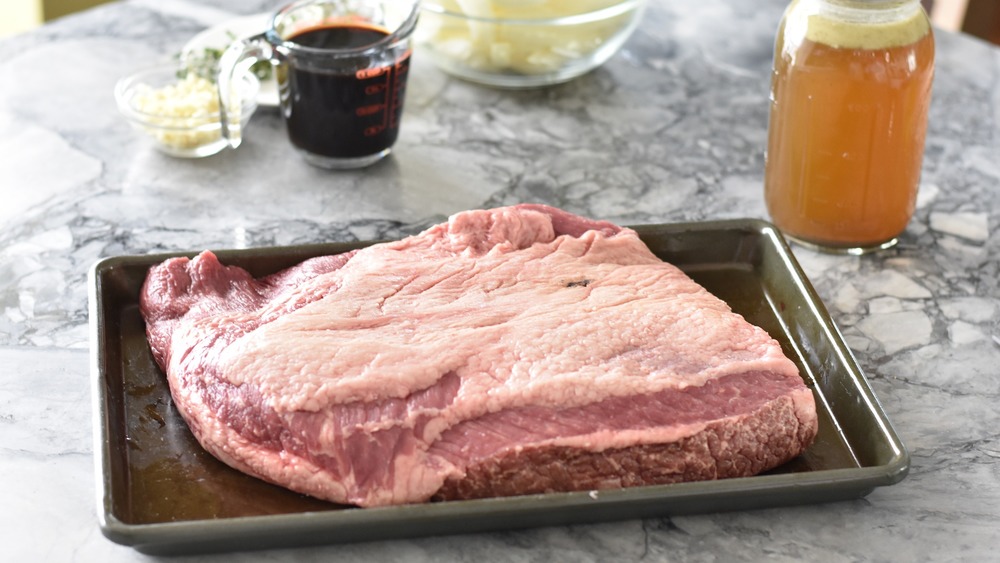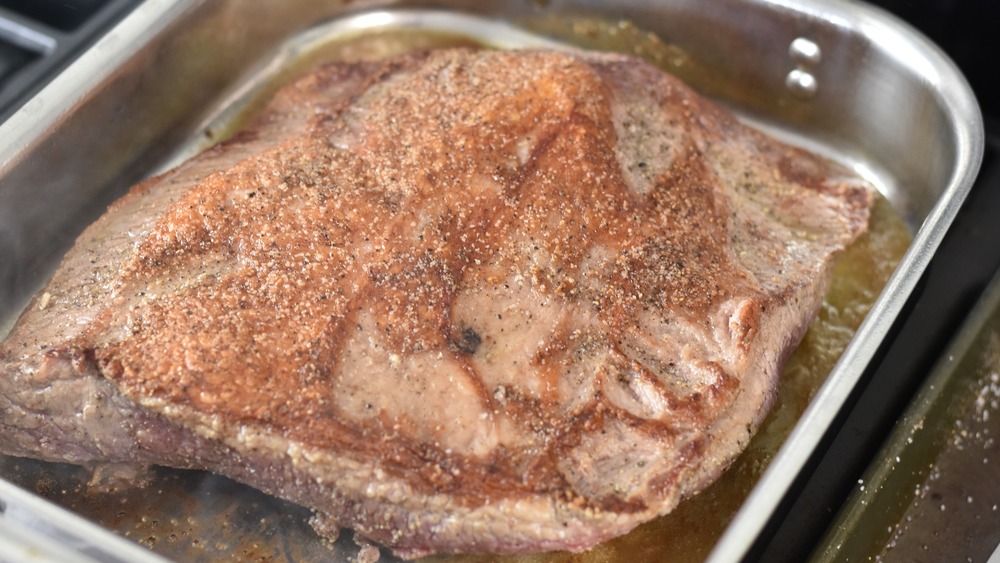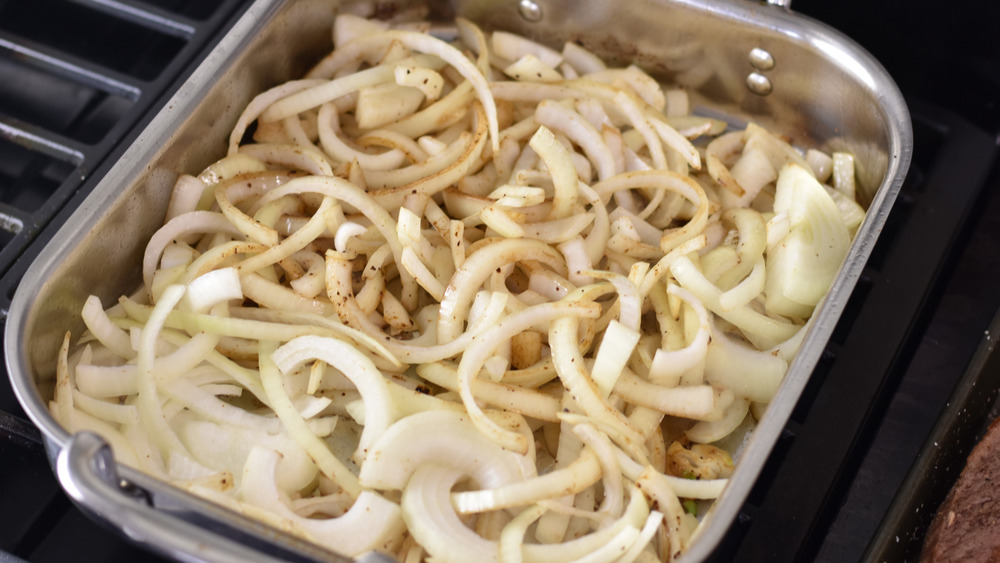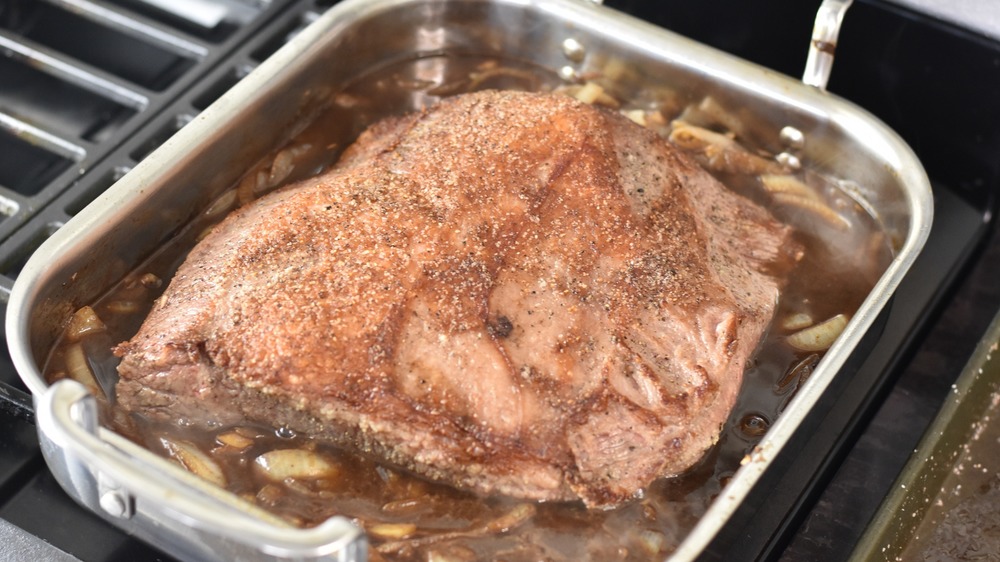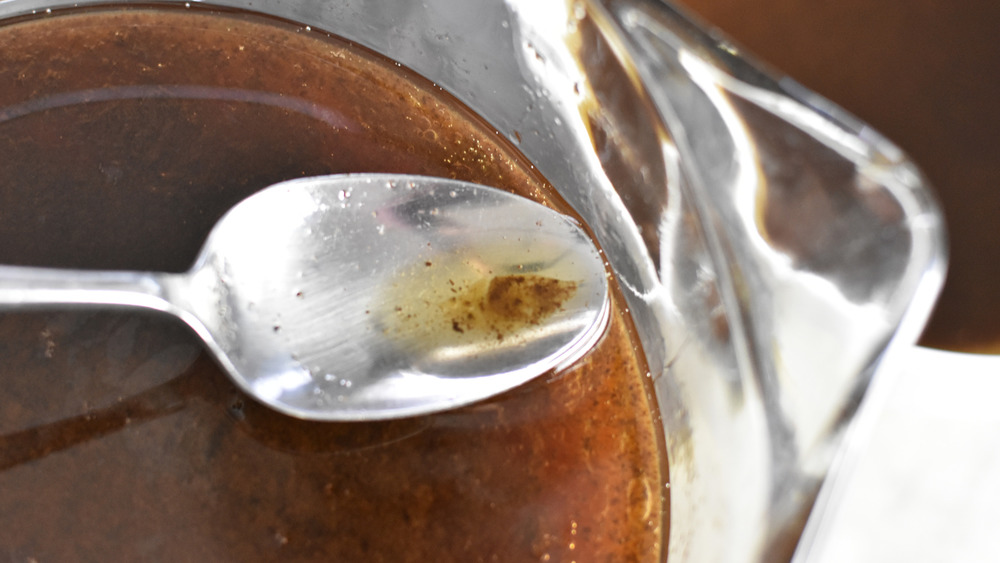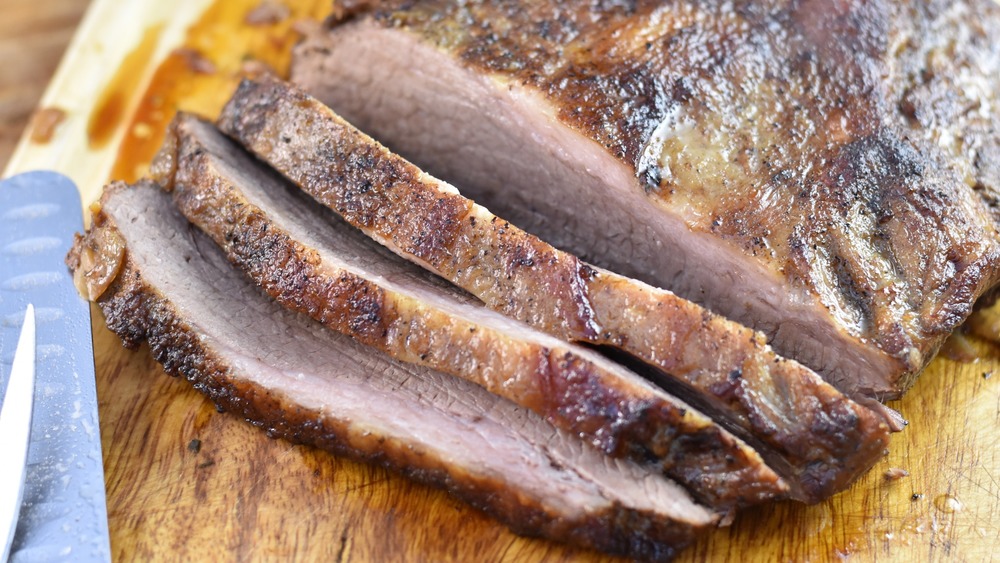Beef Brisket Recipe
Beef brisket is traditionally served at a Passover seder or Rosh Hashanah celebration, according to Food & Wine. However, it's also a perfect meal for any weeknight dinner. On her blog, Pantry to Plate, food writer Stephanie Rapone develops recipes with families in mind. Rapone is a busy working mom and she loves what are, in her words, "cook once, eat twice" meals. "Meaning," as she told us, "we make a big brisket, enjoy it one night, then freeze leftovers, which we enjoy again as reimagined meals in the future."
There really isn't much prep to Rapone's recipe, which largely involves slicing onions, chopping garlic, browning the beef. That's because the brisket does all the work for you simply by braising in the oven. If you've never cooked beef brisket, we'll guide you through every step of the way, including some advice on what cut of brisket to buy. Beef brisket does take several hours to cook, so remember to start Rapone's recipe around lunchtime, meaning that it will be ready by dinner for any night of the week.
Gather together the ingredients for beef brisket
For this recipe, you'll need a beef brisket, large yellow onions, 1 cup of balsamic vinegar, sprigs of fresh thyme, bay leaves, low-sodium beef stock, kosher salt, black pepper, brown sugar, and either vegetable or canola oil.
Prep the aromatics and pat the beef brisket dry
Beef brisket needs about four hours to braise, but it's virtually hands-off once you pop it into the oven. Rapone recommends a brisket that's 4 to 5 pounds, but, if your brisket is larger, then calculate its cooking time as 45 to 60 minutes per pound. Preheat your oven to 300 degrees Fahrenheit and then get ready to prep your aromatics.
Traditionally, brisket is cooked with a lot of onion. In Rapone's recipe, it's three large yellow onions. You'll begin by slicing them and, once you're done, you'll have a mini mountain of onion. But don't worry, as the onion will cook down at least by half during the braise. Rough chop six cloves of garlic and set them aside. Finally, wrap the thyme sprigs in kitchen twine, leaving a few inches of extra twine hanging off the bundle. This makes it easier to pick out thyme later. Run your hand over the fat cap and, if it's thicker than 1/4 inch, trim off the excess.
Sear the beef brisket in the roasting pan
Pat the brisket dry with paper towels. Though it may look a little fussy, this step is important, as it helps the fat layer crisp up. Combine the kosher salt and black pepper in a small bowl, then season both sides of the brisket liberally. You'll need a large roasting pan for this recipe or, as Rapone told us, a huge skillet. Ultimately, you'll need something that's deep enough to hold the brisket, the onions, and the braising liquid, so don't skimp on space.
Put the roasting pan on a stovetop burner. If the pan is large, you'll need to straddle it between two burners. If you're using two burners, take a second to make sure that they're both on.
Then heat 2 tablespoons of vegetable or canola oil in the roasting pan over high heat until it's just beginning to smoke. Lay the brisket fat side down, pressing on it so the fat comes into contact with the hot pan. If you're using two burners of different sizes, you may need to turn the pan a couple of times to get even browning. After 5 minutes, use tongs to flip the brisket over and brown the other side for an additional 5 minutes. Remove the brisket from the pan, and transfer it to a cutting board or another work surface.
Brown the onions for this beef brisket recipe
Using oven mitts, carefully tilt the pan to drain off all of the fat into a heat-resistant bowl. Reserve 2 tablespoons and discard the rest. Rapone reminded us that we should "never put fat down the drain. Let it cool, then discard it in the garbage." You don't want to deal with fat-clogged sink pipes, to be sure. Lower the stovetop burner to medium, and add the reserved fat into the pan, followed by the onions. Spread the onions so they're evenly distributed.
As they soften, the onions will release moisture, which will help loosen the browned bits from the bottom of the pan. Let the onions cook for 7 to 10 minutes, stirring them every couple of minutes. When the onions are softened and partially caramelized, add the chopped garlic and stir for 60 seconds.
Add the remaining ingredients and cook the beef brisket for four hours
Keep the heat on and add the balsamic vinegar to the pan, stirring it until it starts to reduce. Next, add the beef stock and, again, keep stirring so everything in the pan is combined. Nestle the thyme bundle and bay leaves in the onions and increase the heat to high. When the mixture comes to a boil, turn off the heat and carefully lower the brisket into the pan. Cover the pan tightly with aluminum foil and slide the pan into the oven. The low heat and the liquids create the perfect cooking environment for a braise, so low-and-slow is definitely the way to go here.
Once the brisket's in the oven, your work is basically done. After 4 hours, lift the foil and check to see if the brisket is cooked through. It should fall apart easily with a fork. If the brisket's internal temperature registers 200 to 225 degrees Fahrenheit on a meat thermometer, take the pan out of the oven.
Separate the fat for the gravy when the beef brisket is done
Transfer the brisket to a cutting board, tent it loosely with foil, and let it rest while you finish the gravy. You'll need to first remove the rendered fat. To make it easier, use tongs to transfer the onions to a large bowl. Pour the cooking juices from the pan into a measuring cup or fat separator. When the fat rises to the top, skim a spoon along the surface and remove the fat by the spoonful.
Return the onions to the pan and pour in 2 to 2 1/2 cups of the braising liquid, then increase the heat to high. When the liquid comes to a boil, reduce the heat to medium-low.
Finish the gravy, then slice the beef brisket and serve
Stir the brown sugar into the liquid until it's completely dissolved, then let the liquid simmer until it reduces by half. Stir the onions every 2 minutes to check on the gravy's consistency. When it's reduced to your liking, taste the gravy and add more salt and pepper as necessary.
When you're ready to eat, slice the brisket across the grain. Serve it with the onions and gravy ladled on top. As with most braises, the brisket will taste even better the next day and can be used for a variety of leftover purposes. "Shredding it for nachos is amazing!" Rapone said. She also loves cooking brisket because "leftovers make weekday meal prep so much faster."
If you're cooking the brisket ahead of time, don't slice it. Instead, slather the onions on top and wrap the brisket in foil and refrigerate. Refrigerated brisket is much easier to slice thinly, so all you need to do is reheat the onions and gravy, then add the sliced brisket until it's warmed through.
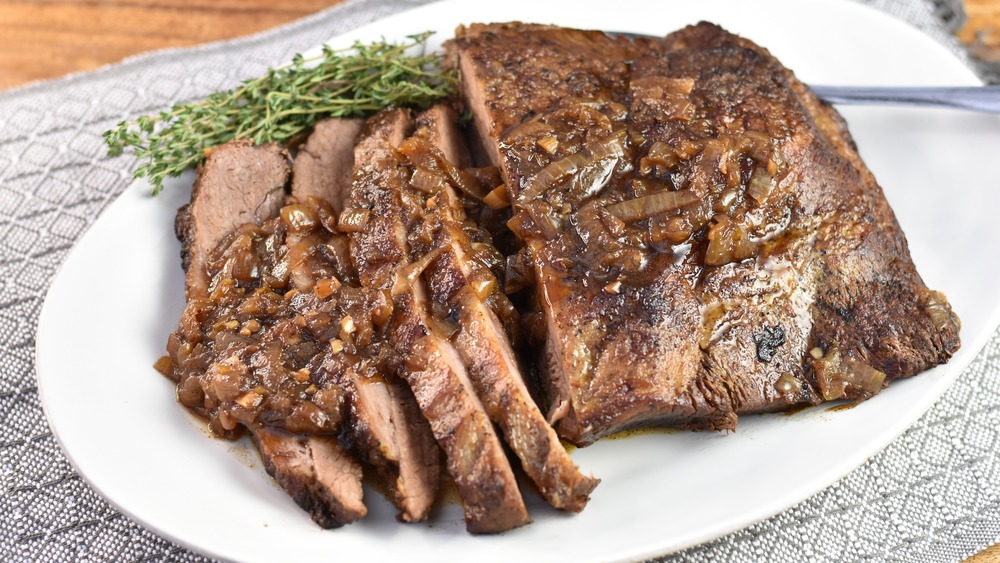
- 4-5 pounds beef brisket
- 3 large yellow onions
- 1 cup balsamic vinegar
- 6-10 sprigs of fresh thyme
- 2 bay leaves
- 32-ounce container low-sodium beef stock
- 1 1/2 tablespoons kosher salt
- 2 teaspoons freshly ground black pepper
- 2 tablespoons brown sugar
- 2 tablespoons vegetable or canola oil
- Preheat oven to 300 degrees Fahrenheit.
- Slice the onions and set them aside. Chop the garlic, and set aside. Tie the thyme sprigs into a bundle using kitchen twine.
- Combine the kosher salt and black pepper. Trim the brisket of fat that is more than 1/4-inch thick.
- Pat the brisket dry with paper towels, then evenly season with the kosher salt and black pepper.
- Heat oil in a roasting pan over high heat. (You may need to straddle the pan between two burners.) Brown the brisket on the fat side for about 5 minutes, pressing down to get as much contact as possible with the roasting pan. Flip the brisket over, and brown the other side for an additional 5 minutes. Transfer the brisket to a plate.
- Reduce the stovetop to medium heat. Using a large spoon, carefully tilt the pan, and remove all but 2 tablespoons of fat. Let the removed fat cool, then discard it in the garbage.
- Add the onions to the roasting pan and brown until they're starting to soften, 7-10 minutes. Stir the onions every couple of minutes to loosen browned bits from the bottom of the pan.
- Add vinegar, and cook 2-3 minutes, stirring until it begins to reduce. Stir in the beef stock, add the thyme, bay leaves, and bring to a boil.
- Turn off the heat, and carefully add the brisket back to the pan. Cover with foil. Bake 4 hours, until the brisket falls apart with a fork.
- Take the roasting pan out of the oven, and transfer the brisket to a cutting board. Loosely cover with foil. Pick out the thyme and bay leaves and discard.
- Strain the juices into a measuring cup or fat separator. Spoon off the fat that rises to the top.
- Add the onions back to the pan over medium-high heat. Add 2-2 1/2 cups of the strained juices, bring to a boil, then reduce the heat to medium-low. Stir in the brown sugar, and simmer, until the gravy reduces by half. Taste and add more kosher salt or black pepper if needed.
- Slice the brisket and serve with onions and gravy.
Nutrition
| Calories per Serving | 651 |
| Total Fat | 48.3 g |
| Saturated Fat | 18.6 g |
| Trans Fat | 0.0 g |
| Cholesterol | 191.9 mg |
| Total Carbohydrates | 12.4 g |
| Dietary Fiber | 1.2 g |
| Total Sugars | 8.0 g |
| Sodium | 867.2 mg |
| Protein | 38.9 g |
